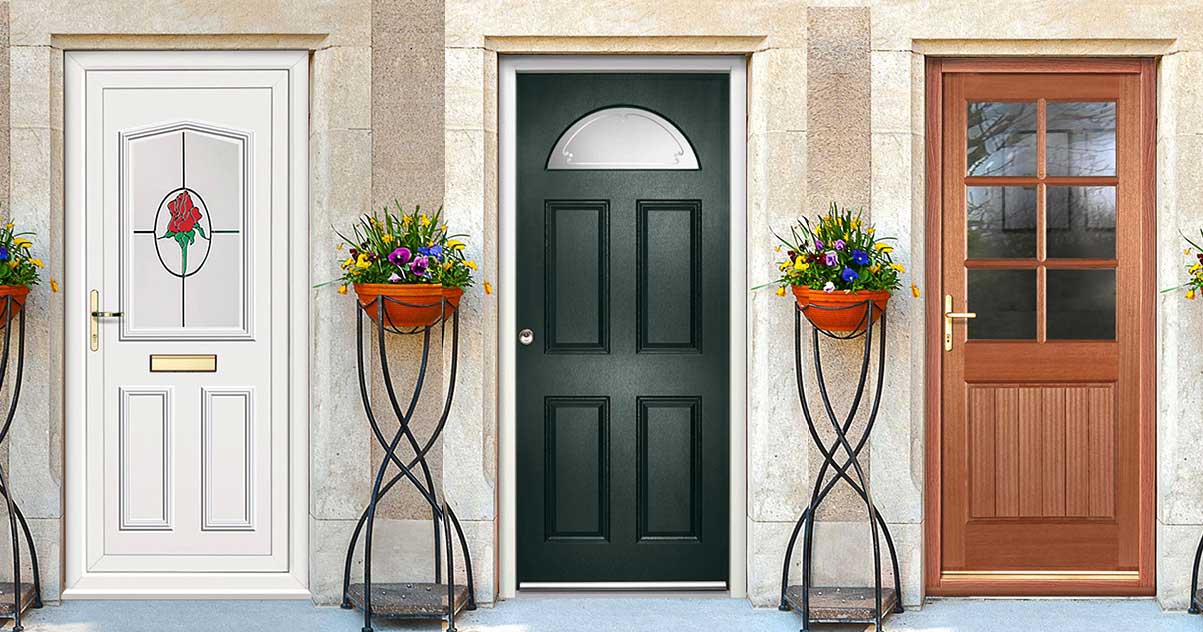The full range of exterior doors available in today’s market include Mahogany, Pine, Oak, PVC and also Composite, a fantastic collection and styles but also a minefield for the unwary.
Most Exterior doors except any made to measure/bespoke doors or frames are usually over-veneered on solid timber, this is in line with a worldwide move to making the best use of our resources and does in my opinion lead to a very stable door with comparable stability to "solid wooden section" doors.
A bespoke range of wooden doors are made using traditional Mortice & Tenon joints, this is accepted as the best way of manufacturing doors but the use of “splined dowels” as a jointing method especially when coupled with the improvements in modern glues has narrowed the construction difference in relation to the quality of joints to almost zero.
Pvc doors are likely to consume less of your time with maintenance but always have that ”narrow” look to them due to the pvc sash (frame) that forms the door which in turn is then fitted to the actual pvc sub frame.
Composite doors go some way to overcoming the Pvc problems of narrowness by being manufactured as a “slab”, ie; the full width of door but then the slab is fitted in to a Pvc frame, both the Pvc and the Composite usually end up with the doorway being made narrower than if a traditional wooden door is fitted, traditional methods are sometimes hard to beat.
The quality of exterior wooden doors when they are treated properly are the best buy you will make, the interesting thing about exterior wooden doors is that even when they have been fitted to a property for 100 years or more they continue to function properly and when they don't they can be added to, reduced in size and different locks or draught excluders added, the same cannot be said about PVC doors, however when all is said and done PVC or Composite doors need minimal maintenance, on more modern properties they can be a better option.
It is our contention that Mahogany doors, Pine doors or indeed Oak doors will and do outlast and outshine PVC & Composite doors, wooden doors are without doubt more aesthetically pleasing on the eye but must be regularly maintained on both the inside and the outside as well as all four edges.
How Much to Pay
Pvc doors are supplied for DIY fitting from starting at approximately £400 + vat but including delivery anywhere on the UK Mainland, it should be remembered that you may also have the costs of a concealed timber sub-frame and also pvc trims as well as silicone sealants.
Composite doors are generally fitted in the same way as pvc doors as described above and start at approximately £700 + vat.
Both the Pvc and the Composite doors arrive at the customer with the door hinged in its own frame and both include any glass, locks, handles or letter plates.
Wooden doors vary greatly in price from Mahogany doors starting at £128 + vat and rise to more than a £1000 + vat for Bespoke Oak doors, if you are also fitting a new frame you can add quite a bit more, it should be remembered that the upside is that you can transfer all your locks, hinges etc if you so wish, if not you must also allow part of your budget for locks, handles, hinges, draught excluders, decoration etc etc.
Decisions may be helped by my thoughts as set out below
Wood:
Pros – When treated correctly exterior wooden doors will last for more than 100 years and are beautiful to look at, with a natural texture. Wood can be adapted in size and repainted in different colours. Door furniture may be easily changed.
Cons – Wooden doors are vulnerable to the elements need to be treated and maintained and can be prone to twisting and warping. Cheap wooden doors can come apart at the joints and may rot if not sealed correctly. Laminated or stabilised timber (small sections glued together) offer greater stability.
uPVC:
Pros – uPVC doors are low maintenance and require no painting or staining. They are well insulated, more stable than timber and usually come with multipoint locking.
Cons - Doors tend to have a ‘narrow’ appearance due to the thickness of the uPVC frame. It will be difficult or impossible to change the size or colour of a door once it has been fitted, or to change locks and door furniture with ease.
Composite:
Pros – Composite doors are made from a mixture of materials, such as glass fibre, which is pressed together and glued under high pressure. These are then clad in an outer skin which can be made to look like real wood but are far stronger, will not warp or require repainting. Virtually indistinguishable from wooden doors, they are highly insulated and are often supplied with multi point locks.
Cons – Composite doors tend to be more expensive than other options.
Any questions, email info@directdoors.com and ask "Chippy"
Edited by " Chippy" for www.directdoors.com
Printable Version
